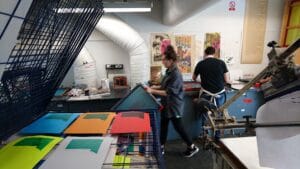Plate Lithography Course
Plate Lithography for Beginners
Tutor: Michael Timmins
Weekend Workshop, €200 (incl. materials)
Sat & Sun, 10am – 5pm
If you have an interest in using your drawing skills within the printmaking process, then this course is for you. Plate lithography offer a wide range of mark-making possibilities and are very versatile, hands-on and open to manipulation. This course gives a complete introduction to Lithography covering drawing on the plates, etching and printing. This course is suitable for beginners.
What is Lithography?
Lithography is a method for printing using a stone (lithographic limestone)with a completely smooth surface. Lithography can be used to print text or artwork onto paper or another suitable material. Lithography works because of the mutual repulsion of oil and water. The image is drawn on the surface of the print plate with a fat or oil-based medium such as a wax crayon, which may be pigmented to make the drawing visible. A wide range of oil-based media is available, but the durability of the image on the stone depends on the lipid content of the material being used, and its ability to withstand water and acid. Following the drawing of the image, an aqueous solution of gum arabic, weakly acidified with nitric acid is applied to the stone. The function of this solution is to create a hydrophilic layer of calcium nitrate salt, and gum arabic on all non-image surfaces. The gum solution penetrates into the pores of the stone, completely surrounding the original image with a hydrophilic layer that will not accept the printing ink. Using lithographic turpentine, the printer then removes any excess of the greasy drawing material, but a hydrophobic molecular film of it remains tightly bonded to the surface of the stone, rejecting the gum arabic and water, but ready to accept the oily ink. When printing, the stone is kept wet with water. Naturally the water is attracted to the layer of gum and salt created by the acid wash. Printing ink based on drying oils such as linseed oil and varnish loaded with pigment is then rolled over the surface. The water repels the greasy ink but the hydrophobic areas left by the original drawing material accept it. When the hydrophobic image is loaded with ink, the stone and paper are run through a press which applies even pressure over the surface, transferring the ink to the paper and off the stone.










